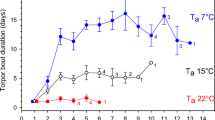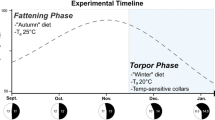Abstract
Timing of winter phenotype expression determines individual chances of survival until the next reproductive season. Environmental cues triggering this seasonal phenotypic transition have rarely been investigated, although they play a central role in the compensation of climatic fluctuations via plastic phenotypic adjustments. Initiation of winter daily torpor use—a widespread energy-saving phenotype—could be primarily timed according to anticipatory seasonal cues (anticipatory cues hypothesis), or flexibly fine-tuned according to actual energy availability (food shortage hypothesis). We conducted a food supplementation experiment on wild heterothermic primates (grey mouse lemurs, Microcebus murinus) at the transition to the food-limited dry season, i.e. the austral winter. As expected under the food shortage hypothesis, food-supplemented individuals postponed the seasonal transition to normal torpor use by 1–2 month(s), spent four times less torpid, and exhibited minimal skin temperature 6 °C higher than control animals. This study provides the first in situ experimental evidence that food availability, rather than abiotic cues, times the launching of torpor use. Fine-tuning of the timing of seasonal phenotypic transitions according to actual food shortage should provide heterotherms with a flexible adaptive mechanism to survive unexpected environmental fluctuations.



Similar content being viewed by others
References
Angilletta MJ, Cooper BS, Schuler MS, Boyles JG (2010) The evolution of thermal physiology in endotherms. Front Biosci E2:861–881
Auld JR, Agrawal AA, Relyea RA (2010) Re-evaluating the costs and limits of adaptive phenotypic plasticity. Proc R Soc B 277:503–511
Bieber C, Juškaitis R, Turbill C, Ruf T (2012) High survival during hibernation affects onset and timing of reproduction. Oecologia 169:155–166
Bieber C, Lebl K, Stalder G, Geiser F, Ruf T (2014) Body mass dependent use of hibernation: why not prolong the active season, if they can? Funct Ecol 28:167–177
Canale CI, Henry P-Y (2010) Adaptive phenotypic plasticity and resilience of vertebrates to increasing climatic unpredictability. Clim Res 43:135–147
Canale CI, Perret M, Théry M, Henry P-Y (2011) Physiological flexibility and acclimation to food shortage in a heterothermic primate. J Exp Biol 214:551–560
Canale CI, Perret M, Henry P-Y (2012) Torpor use during gestation and lactation in a primate. Naturwissenschaften 99:159–163
Cornelius JM, Boswell T, Jenni-Eiermann S, Breuner CW, Ramenofsky M (2013) Contributions of endocrinology to the migration life history of birds. Gen Comp Endocrinol 190:47–60
Dammhahn M (2012) Are personality differences in a small iteroparous mammal maintained by a life-history trade-off? Proc R Soc Lond B 279:2645–2651
Dammhahn M, Kappeler PM (2008a) Small-scale coexistence of two mouse lemur species (Microcebus berthae and M. murinus) within a homogeneous competitive environment. Oecologia 157:473–483
Dammhahn M, Kappeler PM (2008b) Comparative feeding ecology of sympatric Microcebus berthae and M. murinus. Int J Primatol 29:1567–1589
Dammhahn M, Kappeler PM (2013) Seasonality and behavioral energy strategies in Microcebus berthae and M. murinus. In: Masters J, Gamba M, Génin F (eds) Leaping ahead advances in prosimian biology. Springer, New York, pp 215–223
Dausmann KH (2005) Measuring body temperature in the field-evaluation of external vs. implanted transmitters in a small mammal. J Therm Biol 30:195–202
Dawson A (2008) Control of the annual cycle in birds: endocrine constraints and plasticity in response to ecological variability. Philos Trans R Soc Lond B 363:1621–1633
Dewar RE, Richard AF (2007) Evolution in the hypervariable environment of Madagascar. Proc Natl Acad Sci USA 104:13723–13727
Doucette LI, Brigham RM, Pavey CR, Geiser F (2012) Prey availability affects daily torpor by free-ranging Australian owlet-nightjars (Aegotheles cristatus). Oecologia 169:361–372
Florant GL, Healy JE (2012) The regulation of food intake in mammalian hibernators: a review. J Comp Physiol B 182:451–467
Geiser F (2004) Metabolic rate and body temperature reduction during hibernation and daily torpor. Annu Rev Physiol 66:239–274
Geiser F (2013) Hibernation. Curr Biol 23:R188–R193
Génin F, Perret M (2003) Daily hypothermia in captive grey mouse lemurs (Microcebus murinus): effects of photoperiod and food restriction. Comp Biochem Physiol B 136:71–81
Gienapp P, Leimu R, Merilä J (2007) Responses to climate change in avian migration time-microevolution versus phenotypic plasticity. Clim Res 35:25–35
Giroud S, Blanc S, Aujard F, Bertrand F, Gilbert C, Perret M (2008) Chronic food shortage and seasonal modulations of daily torpor and locomotor activity in the grey mouse lemur (Microcebus murinus). Am J Physiol Regul Integr Comp Physiol 294:R1958–R1967
Giroud S, Perret M, Gilbert C, Zahariev A, Goudable J, Le Maho Y, Oudart H, Momken I, Aujard F, Blanc S (2009) Dietary palmitate and linoleate oxidations, oxidative stress, and DNA damage differ according to season in mouse lemurs exposed to a chronic food deprivation. Am J Physiol Regul Integr Comp Physiol 297:R950–R959
Giroud S, Zahn S, Criscuolo F, Chery I, Blanc S, Turbill C, Ruf T (2014) Late-born intermittently fasted juvenile garden dormice use torpor to grow and fatten prior to hibernation: consequences for ageing processes. Proc R Soc Lond B 281:20143111
Heldmaier G, Ortmann S, Elvert R (2004) Natural hypometabolism during hibernation and daily torpor in mammals. Respir Physiol Neurobiol 141:317–329
Helm B, Ben-Shlomo R, Sheriff MJ, Hut RA, Foster R, Barnes BM, Dominoni D (2013) Annual rhythms that underlie phenology: biological time-keeping meets environmental change. Proc R Soc Lond B 280:20130016
Humphries MM, Thomas DW, Kramer DL (2003a) The role of energy availability in mammalian hibernation: a cost-benefit approach. Physiol Biochem Zool 76:165–179
Humphries MM, Kramer DL, Thomas DW (2003b) The role of energy availability in mammalian hibernation: an experimental test in free-ranging eastern chipmunks. Physiol Biochem Zool 76:180–186
Kobbe S, Ganzhorn JU, Dausmann KH (2011) Extreme individual flexibility of heterothermy in free-ranging Malagasy mouse lemurs (Microcebus griseorufus). J Comp Physiol B 181:165–173
Körtner G, Geiser F (2000) The temporal organization of daily torpor and hibernation: circadian and circannual rhythms. Chronobiol Int 17:103–128
Kraus C, Eberle M, Kappeler PM (2008) The costs of risky male behaviour: sex differences in seasonal survival in a small sexually monomorphic primate. Proc R Soc Lond B 275:1635–1644
Lambrechts MM, Perret P (2000) A long photoperiod overrides non-photoperiodic factors in blue tits’ timing of reproduction. Proc R Soc Lond B 267:585–588
Landry-Cuerrier M, Munro D, Thomas DW, Humphries MM (2008) Climate and resource determinants of fundamental and realized metabolic niches of hibernating chipmunks. Ecology 89:3306–3316
Lane JE, Kruuk LEB, Charmantier A, Murie JO, Dobson FS (2012) Delayed phenology and reduced fitness associated with climate change in a wild hibernator. Nature 489:554–557
Miller-Rushing AJ, Høye TT, Inouye DW, Post E (2010) The effects of phenological mismatches on demography. Philos Trans R Soc Lond B 365:3177–3186
Munro D, Thomas DW, Humphries MM (2005) Torpor patterns of hibernating eastern chipmunk Tamias striatus vary in response to the size and fatty acid composition of food hoards. J Anim Ecol 74:692–700
Ozgul A, Childs DZ, Oli MK, Armitage KB, Blumstein DT, Olson LE, Tuljapurkar S, Coulson T (2010) Coupled dynamics of body mass and population growth in response to environmental change. Nature 466:482–485
Patil VP, Morrison SF, Karels TJ, Hik DS (2013) Winter weather versus group thermoregulation: what determines survival in hibernating mammals? Oecologia 173:139–149
Paul MJ, Galang J, Schwartz WJ, Prendergast BJ (2009) Intermediate-duration day lengths unmask reproductive responses to nonphotic environmental cues. Am J Physiol Regul Integr Comp Physiol 296:R1613–R1619
Perret M, Aujard F (2001) Regulation by photoperiod of seasonal changes in body mass and reproductive function in gray mouse lemurs (Microcebus murinus): differential responses by sex. Int J Primatol 22:5–24
Piersma T, Drent J (2003) Phenotypic flexibility and the evolution of organismal design. Trends Ecol Evol 18:228–233
Rasoazanabary E (2006) Male and female activity patterns in Microcebus murinus during the dry season at Kirindy forest, western Madagascar. Int J Primatol 27:437–464
Reed TE, Waples RS, Schindler DE, Hard JJ, Kinnison MT (2010) Phenotypic plasticity and population viability: the importance of environmental predictability. Proc R Soc Lond B 277:3391–3400
Schmid J (1998) Tree holes used for resting by gray mouse lemurs (Microcebus murinus) in Madagascar: insulation capacities and energetic consequences. Int J Primatol 19:797–809
Schmid J (2001) Daily torpor in free-ranging gray mouse lemurs (Microcebus murinus) in Madagascar. Int J Primatol 22:1021–1031
Schmid J, Ganzhorn JU (2009) Optional strategies for reduced metabolism in gray mouse lemurs. Naturwissenschaften 96:737–741
Schmid J, Kappeler PM (1998) Fluctuating sexual dimorphism and differential hibernation by sex in a primate, the gray mouse lemur (Microcebus murinus). Behav Ecol Sociobiol 43:125–132
Sheriff MJ, Kenagy GJ, Richter M, Lee T, Tøien O, Kohl F, Buck CL, Barnes BM (2011) Phenological variation in annual timing of hibernation and breeding in nearby populations of arctic ground squirrels. Proc R Soc Lond B 278:2369–2375
Sheriff MJ, Williams CT, Kenagy GJ, Buck CL, Barnes BM (2012) Thermoregulatory changes anticipate hibernation onset by 45 days: data from free-living arctic ground squirrels. J Comp Physiol B 182:841–847
Sheriff MJ, Fridinger RW, Tøien Ø, Barnes BM, Buck CL (2013a) Metabolic rate and prehibernation fattening in free-living arctic ground squirrels. Physiol Biochem Zool 86:515–527
Sheriff MJ, Richter MM, Buck CL, Barnes BM (2013b) Changing seasonality and phenological responses of free-living male arctic ground squirrels: the importance of sex. Philos Trans R Soc Lond B 368:20120480
Stearns SC (1992) The evolution of life histories. Oxford University Press, Oxford
Terrien J, Perret M, Aujard F (2010) Gender markedly modulates behavioral thermoregulation in a non-human primate species, the mouse lemur (Microcebus murinus). Physiol Behav 101:469–473
Thomas DW, Blondel J, Perret P, Lambrechts MM, Speakman JR (2001) Energetic and fitness costs of mismatching resource supply and demand in seasonally breeding birds. Science 291:2598–2600
Turbill C, Bieber C, Ruf T (2011) Hibernation is associated with increased survival and the evolution of slow life histories among mammals. Proc R Soc Lond B 278:3355–3363
Visser ME, Caro SP, van Oers K, Schaper SV, Helm B (2010) Phenology, seasonal timing and circannual rhythms: towards a unified framework. Philos Trans R Soc Lond B 365:3113–3127
Vuarin P, Henry P-Y (2014) Field evidence for a proximate role of food shortage in the regulation of hibernation and daily torpor: a review. J Comp Physiol B 184:683–697
Vuarin P, Dammhahn M, Henry P-Y (2013) Individual flexibility in energy saving: body size and condition constrain torpor use. Funct Ecol 27:793–799
Williams CT, Barnes BM, Kenagy GJ, Buck CL (2014) Phenology of hibernation and reproduction in ground squirrels: integration of environmental cues with endogenous programming. J Zool 292:112–124
Acknowledgments
We acknowledge the support of this study by Prof. Daniel Rakotondravony and the other members of the Département de Biologie Animale, Université d’Antananarivo, the Commission Tripartite, and the CAFF of the Direction des Eaux et Forêts, and the CNFEREF Morondava. This study was partly funded by CNRS and MNHN (UMR 7179), the German Primate Centre and the Ethologische Gesellschaft. The authors declare that they have no conflict of interest. We thank Martine Perret, Rodin Rasoloarison and Léonard Razafimanantsoa for their support, as well as Susanne Schliehe-Diecks, Bruno Tsiverimana, Jean-Pierre Tolojanahary and the Kirindy team for assistance in the field.
Author information
Authors and Affiliations
Corresponding author
Additional information
Communicated by Joanna E. Lambert.
Electronic supplementary material
Below is the link to the electronic supplementary material.
Rights and permissions
About this article
Cite this article
Vuarin, P., Dammhahn, M., Kappeler, P.M. et al. When to initiate torpor use? Food availability times the transition to winter phenotype in a tropical heterotherm. Oecologia 179, 43–53 (2015). https://doi.org/10.1007/s00442-015-3328-0
Received:
Accepted:
Published:
Issue Date:
DOI: https://doi.org/10.1007/s00442-015-3328-0




